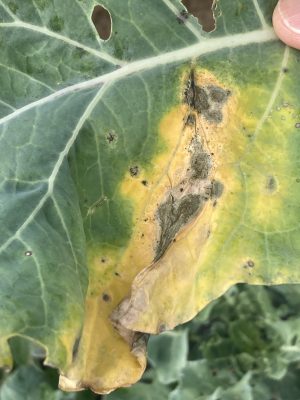
Black rot, caused by the bacterium Xanthomonas campestris pv. campestris, is the most common and destructive disease of the cabbage family worldwide. The bacterium is introduced to fields through infected seeds or transplants. Once present, it may survive on decomposing crop residue for up to two years, or indefinitely on weeds in the crucifer family. The black rot pathogen develops fastest during warm (80 to 95°F) and moist conditions. The disease is spread quickly between plants in a row by splashing rain and gains entry through water pores at leaf margins or through wounds on plant tissue.
Early symptoms appear as wedge-shaped chlorotic (yellow) patches along the edge of the leaf that point toward the midrib. Veins in the discolored area darken as the interveinal tissue dies and becomes brown and brittle. Eventually the bacteria enter the vascular system of the plant and the disease becomes systemic, producing leaf drop and head rot. Crop loss can be extensive. A crosswise cut of the stem, leaf petiole or veins will reveal a darkened ring of vascular tissue.

Damage from this disease can usually be avoided by using an integrated approach to disease management.
Disease management
- Most of the black rot epidemics have been introduced on infected transplants from the southern states. It is advised to grow your own transplants or source them locally.
- Hot water seed treatment can help reduce or eliminate the seedborne pathogen.
- Grow transplants in a soilless mix or use a new, pasteurized or fumigated seedbed.
- Avoid planting in low, wet sites with poor soil drainage. Planting on raised beds, which provide better soil drainage, may help reduce disease spread, especially in seed beds.
- Implementing plastic mulch on raised beds can help reduce water splashing.
- Avoid planting in fields infested with weeds in the crucifer family, which may harbor the black rot organism from previous years.
- Use different seed lots to plant several smaller seed beds rather than one large bed. Inspect seedlings for black rot symptoms frequently and rogue infected and surrounding plants immediately.
- Avoid working in fields when the foliage is wet.
- Plow cole crop fields after harvest to hasten the decomposition of crop residues.
- Manage weeds, especially those in the crucifer family such as mustard and shepherdspurse,
- Practice a 3 year rotation between cole crop plantings.
- If infection occurs, fixed copper or copper hydroxide applications every 7 to 10 days may slow the spread of this disease in dry seasons.
- Use black rot resistant varieties, detailed below.
|
Black Rot Resistant and Tolerant Varieties |
||
| Black Rot Resistant Cabbage | Guardian Defender Gladiator |
|
| Black Rot Tolerant Cabbage | Bravo Green Cup Rio Verde* Atlantis |
Blueboy Red Dynasty Early Thunder Blue Thunder Arena |
| Black Rot Tolerant Broccoli | Arcadia Eureka |
|
| Note: Varieties considered to be tolerant will withstand less disease pressure than those considered resistant. | ||
| *Note: One field of Rio Verde in Connecticut was observed to be severely infected with black rot. If you have problems with this variety, please contact one of the editors. | ||
Initially written by Jude Boucher, Integrated Pest Management, University of Connecticut.
Updated in 2023 by Maggie Ng and Shuresh Ghimire.
Reprinted from: Grower, Volume 92-6
This information was developed for conditions in the Northeast. Use in other geographical areas may be inappropriate.
The information in this document is for educational purposes only. The recommendations contained are based on the best available knowledge at the time of publication. Any reference to commercial products, trade or brand names is for information only, and no endorsement or approval is intended. The Cooperative Extension System does not guarantee or warrant the standard of any product referenced or imply approval of the product to the exclusion of others which also may be available. The University of Connecticut, Cooperative Extension System, College of Agriculture and Natural Resources is an equal opportunity program provider and employer.